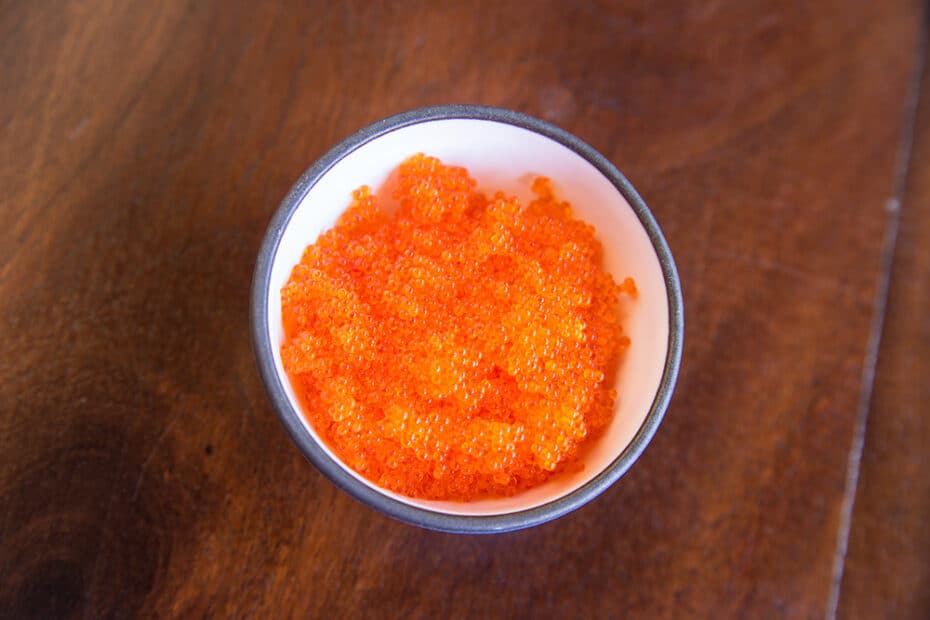If you’ve eaten sushi you’ve likely already seen or tried tobiko. It’s used to add color and a crunchy texture to many sushi rolls,
This post is dedicated to all things tobiko. Learn about the species used, different types of tobiko, flavor profiles, sustainability, and more.
What is Tobiko?
Tobiko (とびこ) is the roe of flying fish. It’s often dyed and flavored. There are dozens of species of flying fish, of which several are popular for their roe. Tobiko is small, orange, and has a snappy texture. The flavor is naturally mild and briny.
The word tobiko is a shortening of “tobiuo no ko,” or “flying fish eggs.”
Tobiko is especially popular in the West. It’s served on its own as gunkan-style sushi and used as a garnish on top of nigiri and chirashi. But most Americans will be familiar with tobiko from its use on California rolls and other types of uramaki.
Flying Fish
Flying fish are generally fish of the open ocean and are most often found in tropical and subtropical waters. They feed primarily on zooplankton. Notably, flying fish have developed the ability to glide in the air to escape predation.
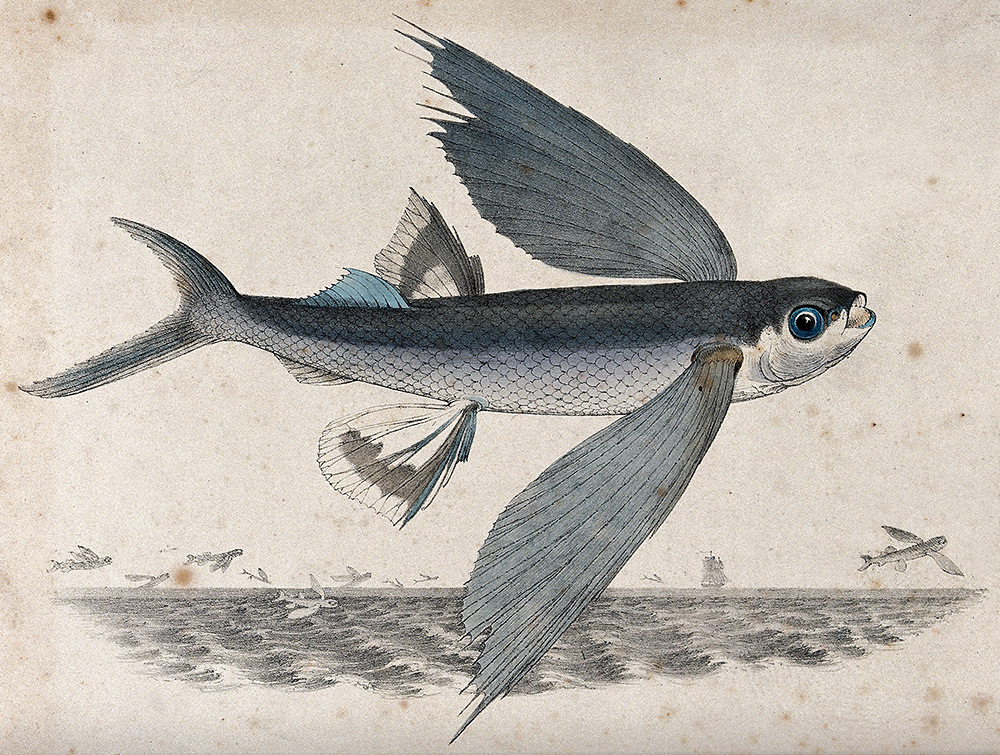
What Does Tobiko Taste Like?
Tobiko has a crunchy texture with a satisfying pop. They have a mildly sweet and briny flavor. Tobiko also tends to have a citrusy taste similar to orange zest.
Additionally, most commercial examples of tobiko are cured with sake vinegar and mirin. The sweet-sour rice flavors of these ingredients don’t overpower the roe, however.
Dashi or dashi extract is also commonly used for curing commercially available tobiko. This adds umami and a subtle smoky flavor.
Types of Tobiko
High-end, fresh tobiko will usually be cured simply in salt. This will have a light golden color and a sweet-briny flavor.
But the vast majority of tobiko one will encounter are processed with many more ingredients than simply salt.
A variety of commercial flying fish roe types of been popularized. They can be differentiated by color and usually have an added ingredient or two that makes them taste and look somewhat different.
As mentioned previously, most commercial examples of tobiko will contain sake vinegar and mirin. Soy sauce, salt, and sugar are also commonly used for curing. Preservatives and food coloring are also standard ingredients. And lastly, some commercial examples of flying fish roe will contain dashi or dashi extract.
Below we detail the most common varieties of tobiko.
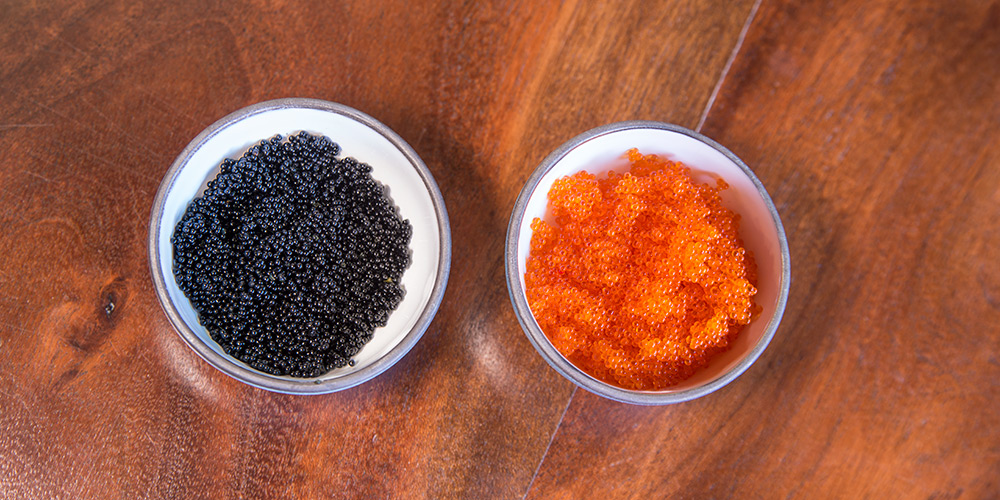
Golden Tobiko
High-quality and fresh tobiko may be called golden tobiko. This would be cured simply in salt and have a milder flavor profile than most commercial examples.
Most of the time, golden tobiko will be processed with the standard curing ingredients and preservatives. Food coloring may also be used.
Orange Tobiko
Orange tobiko is the most common type of commercially processed flying fish roe. It has a sweet, briny, and citrusy flavor. Orange zest, steamed rice, and mild smoke notes are also present.
Orange tobiko rose to fame in the West because it’s often placed on top of California rolls. Today, orange tobiko and masago are commonly interchanged on this classic sushi roll. Tobiko has a much crunchier texture than masago, however.
Salt, sugar, soy sauce, rice vinegar, mirin, dashi extract, and preservatives are all often used for curing. FD&C Yellow No. 6 (sunset yellow) is used for coloring.
Black Tobiko
Black tobiko gets some of its inky appearance from squid ink. This type of flying fish roe has a similar flavor to other commercial varieties, but a bit more umami and a flavor similar to octopus. Black tobiko also has a mild nutty and bitter taste.
Black tobiko has an opaque appearance. This is unlike other forms of flying fish eggs with are translucent.
A variety of ingredients are used to cure and color black tobiko. Besides squid ink, FD&C Yellow #6, Blue #1, and Red #40 food colorings are also common. The usual slate of salt, sugar, mirin, sake vinegar, dashi extract, and preservatives are also used in the curing process.
Yellow Tobiko
Yellow tobiko is usually flavored with yuzu and/or other types of citrus. It has a bright yellow color that’s usually derived from food dye.
Some commercial varieties of yellow tobiko use ginger, as well.
Like other commercial types of flying fish eggs, yellow tobiko is usually cured with some combination of salt, sugar (or fructose), mirin, rice wine vinegar, and soy sauce. Dashi or dashi extract is also common.
Red Tobiko
Red tobiko gets its color and added flavor from beets or chilis. The flavor of red tobiko will have a bit of spice if chili is used. Otherwise, it is very similar to orange tobiko.
Besides beets or chilis, FD&C Yellow #6, Blue #1, and Red #40 food dyes are also used to produce red tobiko’s vibrant color. A combination of salt, sugar, mirin, sake vinegar, dashi extract, and preservatives are also commonly used for curing and flavoring.
Wasabi Tobiko
Wasabi tobiko has a spicy flavor derived from wasabi or wasabi extract. It’s otherwise similar in flavor and texture to other types of flying fish roe.
Green tobiko is another name for this type of flying fish roe. Food dyes FD&C Yellow #5 and Blue #1 are usually used to added to create the vibrant green color.
Common curing and flavoring ingredients for wasabi tobiko include salt, sugar, mirin, sake vinegar, soy sauce, and dashi extract. Preservatives are almost always used, as well.
Where to Buy Tobiko
Tobiko is not very expensive. And because it freezes well, it can be found year-round.
It’s easy to find at Japanese restaurants. But if you’re making sushi at home, your best bets are Asian grocers or online.
Some Japanese markets sell frozen masago and/or tobiko. Uwajimaya and Mitsuwa are two chains worth checking out. High-end seafood markets are also worth a shot.
But for most of the country, shopping online is the easiest, cheapest, and fastest way to buy tobiko.
Below are a few online retailers with quality roe. I’m an affiliate advertiser for some of them and may earn commissions on qualifying purchases.
Buy Tobiko Online
Comparable Roe
Tobiko is most similar to masago and ebiko. Masago, which is smelt roe, is almost as common as tobiko, and is sometimes used as a substitute.
Though they appear similar superficially, tobiko is probably a little superior to masago. Why? It has a richer color, a firmer texture, and more flavor. Tobiko is also slightly larger. Learn more about masago vs tobiko here.
Ebiko is shrimp roe. It’s much more common in Japan than in North America. But it’s somewhat similar to tobiko in appearance, flavor, and texture.
Finally, salmon roe (ikura) is another fish egg often available at the sushi bar. Regardless of the salmon species, ikura is much bigger than tobiko. Ikura also has a softer, gooey texture with way more salty umami.
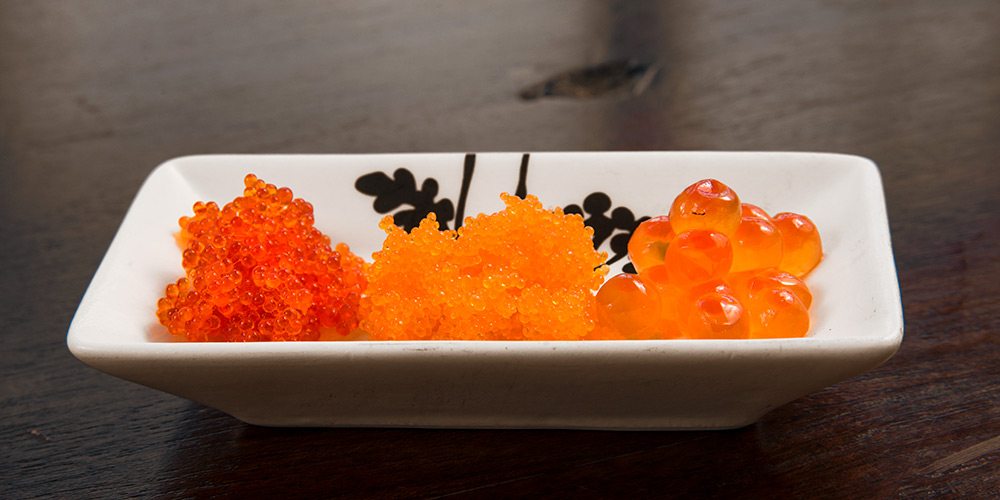
Occasionally, you might find sturgeon roe, or caviar, at high-end Japanese restaurants. The texture of sturgeon eggs is softer, their appearance is opaque and dark, and they have a fuller flavor. Like salmon roe, many types of sturgeon roe exist. But overall, they’re much more expensive than tobiko and masago.
Serving Tobiko
Both flying fish and capelin roe are popular as sushi and used in several similar ways.
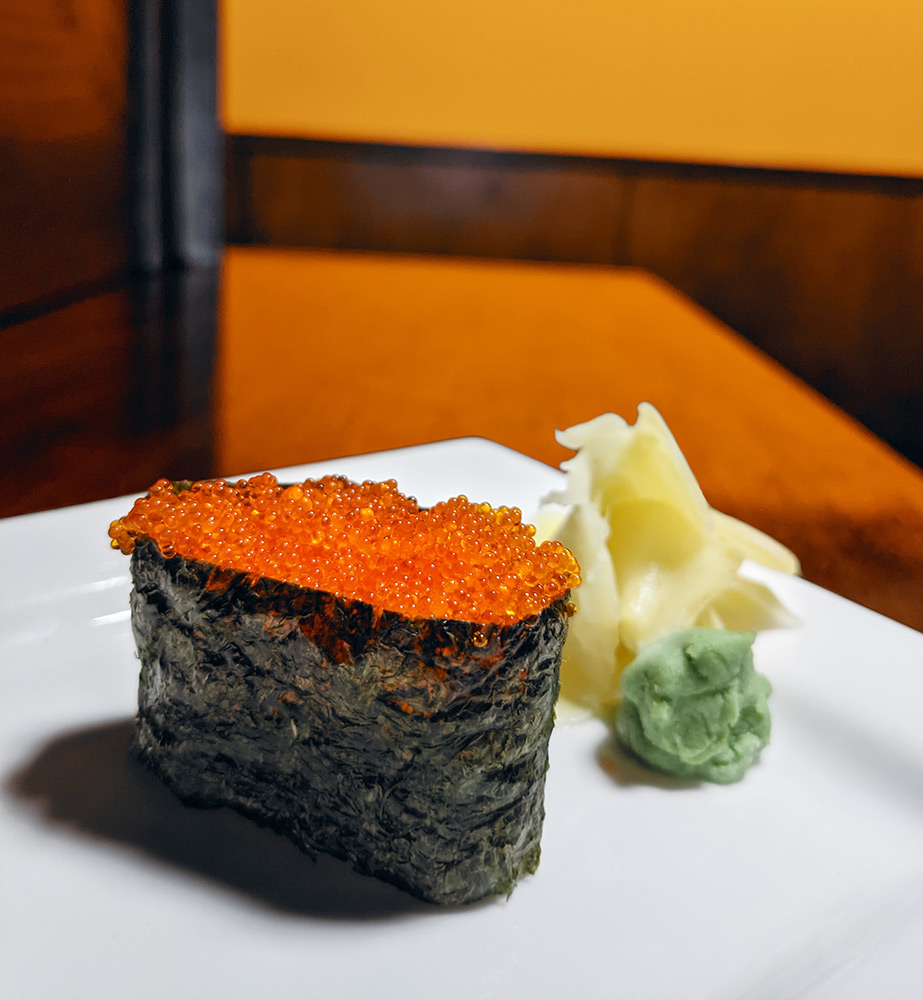
Tobiko Sushi
The most common way tobiko is used in sushi restaurants is on the outside of uramaki. The California roll is the most famous of these inside-out rolls and helped popularize tobiko in the West.
You’ll also often find tobiko placed on top of nigiri as a colorful garnish. And it’s also commonly used on chirashi sushi.
Gunkan tobiko isn’t commonly served at high-end sushi restaurants in Japan. However, tobiko sushi is popular at more modest sushi restaurants and izakayas.
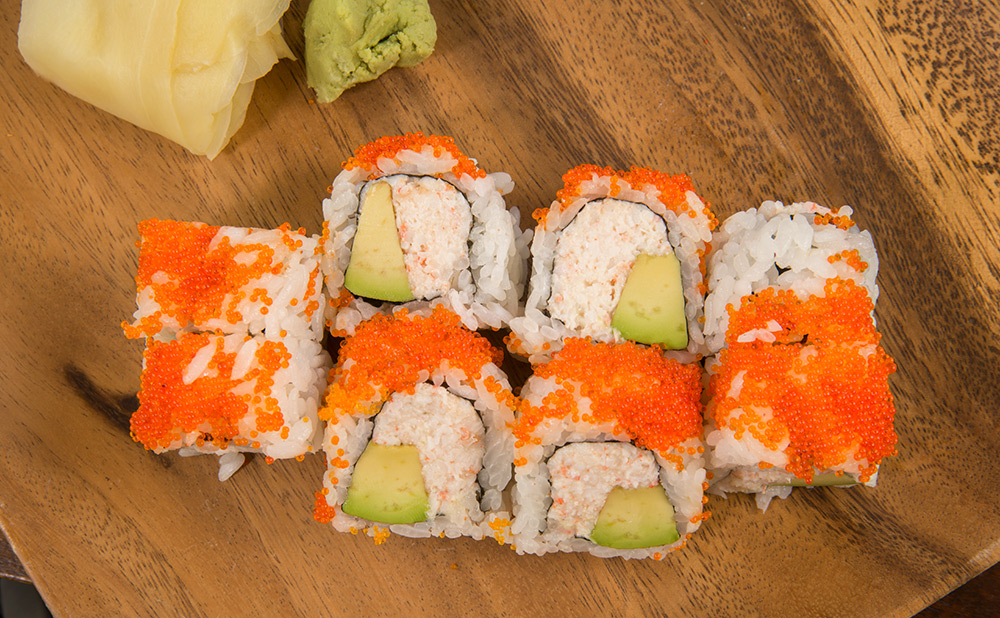
Other Ways to Enjoy Flying Fish
Tobiko makes a great addition to pasta and salads.
They also can be used as garnishes and to add color to many western dishes. They look especially good on top of raw oysters. Similarly, tobiko and masago sometimes find their way into oyster shooters. However, ikura is more commonly used for this purpose.
Tobiko Sushi Drink Pairings
There are many types of alcoholic beverages that pair well with tobiko and masago. These beverage pairings focus specifically on these fish roes. So the pairings work best with gunkan and sashimi presentations of tobiko and masago.
Pairing Flying Fish Roe with Sake and Beer
Sake makes a delicious pairing with both masago and tobiko. Look for sake styles that aren’t too rich or earthy and you’re good to go.
Sparkling sake, which often has some sweetness, makes for an excellent pairing too. The sweet ricey flavors marry with the salty-sweet umami of the fish roe. The bubbles and acidity then work to cleanse the palate.
Beer and fish roe can be a good pairing if the beer isn’t too strong. Lighter lagers like Sapporo Premium and Asahi Super Dry fit the bill. German Pils and Czech Pilsner are more flavorful than those Japanese beers but will still taste great with masago and tobiko. If you can find it, the subtly smoked Schlenkerla Helles rauchbier is outstanding with tobiko.
Wine Pairings with Tobiko
Fruity sparkling wine is also a nice pairing choice for the same reason that sparkling sake works so well. Prosecco is an especially a good option. Moscato d’Asti is a good choice too, and it really shines with wasabi tobiko and masago.
Dry sparkling wines like Cava and Champagne also make an elegant and refreshing pairing with most types of fish roe.
Still white wines often pair well with flying fish and smelt roe. This is especially true if they have briny or mineral elements, and also with wines that have some residual sugar.
Muscadet, Chablis, and Santorini Assyrtiko are delicious examples of the former. Demi-sec Vouvray and some Pinot Gris are examples of the latter. And German Kabinett Reisling has a little of both.
As a bonus, all of these wines work with a ton of other dishes you’ll find in a Japanese restaurant.
Get more sushi and wine pairing suggestions to improve your next meal.
Recommended Shochu Pairings
Lastly, vodka and caviar is a classic pairing. A Japanese twist on this idea that works well is honkaku rice or barley shochu. It’s best to stick to shochu which’s between 20-24% ABV. Brands like Iichiko Silhouette, Kawabe, and Hakutake Shiro are great choices to pair with tobiko and masago as gunkanmaki.
Dietary and Nutritional Information
Tobiko and masago are both nutrient-rich, and they’re low in calories and carbs. Both are loaded with healthy fats like Omega-3 fatty acids. They’re also high in protein and minerals.
Masago and tobiko are both rich in vitamins. Vitamin B12 levels are especially high. Vitamin C and E levels are also somewhat high.
Mercury levels for both types of fish eggs are also much lower than larger predatory fish like tuna and mackerel.
The major downside of masago and tobiko is high levels of sodium. The use of salt, and sometimes soy sauce, only adds to their sodium levels.
High fructose corn syrup is also commonly used for processing masago.
Is Tobiko Gluten Free?
Naturally, both tobiko and masago contain no gluten. However, many commercially available examples of these fish roes use some soy sauce for curing. Soy sauce is not gluten-free, so be sure to check the label or ask the chef about the ingredients list.
Proper Storage of Tobiko
Tobiko and masago both freeze well and don’t lose their texture and flavor. Once thawed, keep them refrigerated. They’ll taste best within 3 or 4 days.
Sustainability
Both of these fish have multiple species, commercial uses, and fisheries across the globe. Pinpointing an exact answer is challenging, but we can get you close.
Is Tobiko Sustainable?
There are dozens of species of flying fish located across the globe. The fish themselves are often eaten, and their eggs are popular as tobiko. Different fisheries exist for the adults and for the eggs.
Overall, the practice of harvesting eggs limits the size of future generations of flying fish. The populations near Taiwan, southern Japan, and the East China Sea are considered healthy. But they’re susceptible to overfishing.
Follow the Japanese Bar on Social Media
Connect with my latest posts, the newest Japanese beverage info, and get exclusive promotional offers. Level up your Japanese food and beverage IQ!
Conclusion
Did I miss anything?! If you want to know more about masago or tobiko, please let me know.
I’m also curious, have you used tobiko or masago at home? It’s easy to use in sushi rolls and nigiri. But have you tried it? And if so, any tips for everyone else?
Finally, if you want to master the sushi bar, check out my sushi and sashimi guide.
